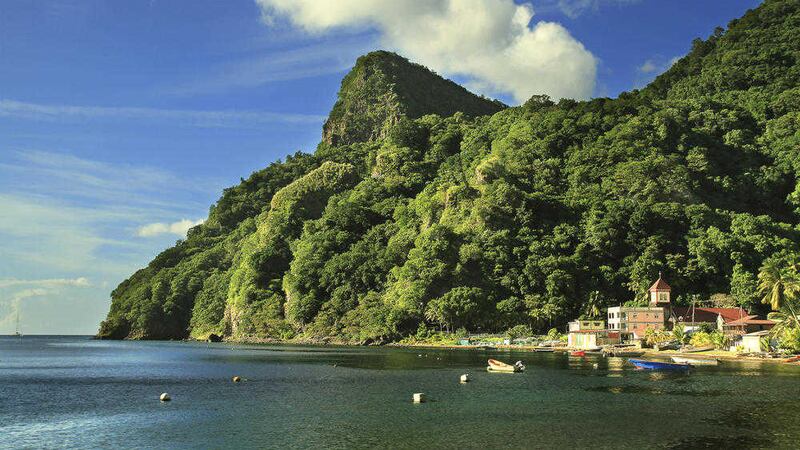THE lush green island of Dominica, unfairly receiving so little attention, is the Cinderella of the Caribbean.
This makes it charming as well as an antidote to clichéd image of the Caribbean. There are few hyper-expensive resorts, no super-rich glitterati hiding in gated mansions behind high walls, no oversized private yachts idling off shore.
What you do get is stunning natural beauty, dormant volcanoes clad in blankets of tropical vegetation, national parks, walking trails through rainforest and valleys, and turquoise waters in gorgeous bays where the snorkelling is superb.
OK, cruises do call in over the European winter months, disgorging parties of sightseers, but it’s possible to avoid them and the rest of the year it will feel as if you have the island to yourself. Some 70,000 visitors stayed here for more than a day trip in 2014; compare that number with the five million who flooded the Dominican Republic, the country often confused with Dominica.
Dominica is a small island, 29 miles long and 16 wide, first conquered by the French only to have it filched from them by the British in 1763. While some locations still have Gallic names, like the capital Roseau, you’ll find the second largest town is called Portsmouth, everyone speaking English, driving on the left and using familiar three-pin sockets.
Take a twenty-minute flight to neighbouring Guadeloupe or Martinique and you’ll need a plug adaptor, euros to buy anything and some French to make yourself understood.
With a total population a lot smaller than Derry’s, there are few urban centres and Roseau needs less than a day to explore. In the restaurant at Roseau’s top hotel, Fort Young, dining on the balcony offers expansive views of the Caribbean Sea, a bottle of wine costs around £15 and a generous shot of a local rum £2.
The food market in the capital is well worth visiting early on a Saturday morning for its array of strange fruits and vegetables – dasheen, breadfruit, soursop, tannia, canep – and the opportunity to purchase bagfuls of cinnamon bark and turmeric rhizomes for next to nothing.
Roseau dates back to the early 18th century and the elegance of the architecture – faded in parts, elsewhere enlivened by fresh paint in bright colours – is beguiling: jalousie windows, verandas teeming with flowers, the grand bishop’s house (most Dominicans are Catholics) with a lovely line of mango trees alongside it, the barracoon where slaves were barracked before being sold outside.
A neat excursion from the capital takes you along a coastal road to Scots Head at the southern end of the island, from where you can walk across a causeway to the headland. The Caribbean lays calmly on your right, the swell of the Atlantic to your left, with safe swimming in both seas and less than a dozen paces separating them.
The scene from atop the headland is staggeringly beautiful, with Martinique visible to the south and snorkelers drifting below on the Caribbean side.
Dominica’s interior is filled with rivers, waterfalls, verdant volcanoes and signposted trails. You could begin walking with an easy, 45-minute stroll to Middleham Falls or around one of the lakes in the Roseau valley. Stamina is required – guides are advisable (£33 per person) but not essential – for the dramatic hike to the Boiling Lake, the trekking highlight of Dominica.
It takes three hours each way, the effort rewarded by climactic views of a flooded fumarole, heated from below to boiling point by a magma chamber, and the journey there through what sounds like the title of a Dylan album, the Valley of Desolation. Less demanding are many of the sections making up the Waitukubuli National Trail that criss-crosses the island.
Other activities range from water sports to horseback riding on a beach, with your horse ploughing through the water up to its shoulders and enjoying the experience as much as rider. The tropical vegetation is magical, with heliconias lighting up the hundred hues of green, and gommier trees, which the indigenous Kalinago of Dominica hewed to make their canoes, are common everywhere.
Communally owned territory on the east coast belongs to the Kalinago and their cultural village is worth visiting, if only to see the cassava bakery and taste the bread. On the walking trails it is not difficult to spot hummingbirds hovering and flying backwards in mid-air.
Calabishie, on the northeast coast of Dominica close to the airport, is a visitor-friendly village that offers all you need for an idyllic break from routine life. The uncrowded beaches are sandy, with views of the French Antilles on the horizon, the village itself strung out along the road with banana and coconut trees swaying moodily in the background.
There are plenty of self-catering apartments and pretty bungalows for rent by the day (calibishie-lodges.com, windblowestate.com, bayviewlodges.com, dominicasseaviewappartments.com, dominica-cottages.com), shops, restaurants, buses.
Elma Napier and her husband dropped out of high society life in London and came to live just south of Calabishie in 1932 with their young children. Her Black and White Sands (papillotepress.co.uk) is a great in-situ read and her home at Pointe Baptiste can be rented (pointebaptiste.com); in the grounds, her grandson makes chocolate for sale (try the lemongrass variety).
Point Babtiste has a terrific beach and the suitably named Escape Bar and Grill is tucked away here.
FACTFILE
:: British Airways (britishairways.com) fly direct from London to Barbados and Antigua and there are local flights from both islands to Dominica (liat.com).
:: April to July misses the cruise season (December-April); August and September are quiet months due to this being the hurricane season in the Caribbean, though I was there this September and enjoyed perfect weather. Temperatures average around 30C throughout the year.
:: An inexpensive bus system uses shared minivans and they can be hailed down along the roads; a hired car is the best way to get around but roads have countless bends and beeping the horn constantly is standard (and essential) safe practice. I used Happy Car Rentals (jenna23dm@yahoo.com) and Jen Tours (jentours.com).
:: For accommodation, resorts, hotels, cottages and apartments are spread throughout the island serving all budgets; check out Fort Young hotel in Roseau (fortyounghotel.com), Coco Cottages (cococottages.com) and, with the best restaurant on the island, Picard Beach Cottages (picardbeachcottages.dm).
:: For info, dominica.dm, the island’s tourist authority; Bradt’s Dominica travel guide (bradtguides.com) is comprehensive and covers all the walking trails in detail.







